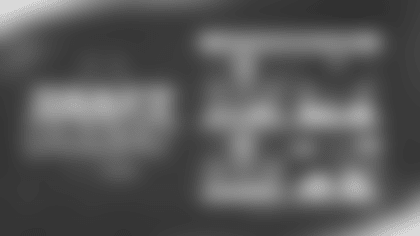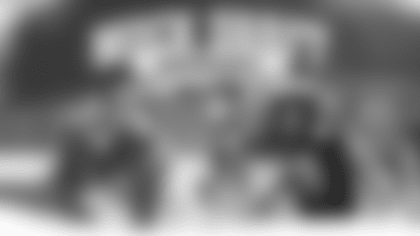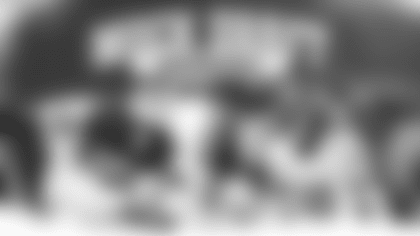The analysis from those producing content on Colts.com does not necessarily represent the thoughts of the Indianapolis Colts organization. Any conjecture, analysis or opinions formed by Colts.com content creators is not based on inside knowledge gained from team officials, players or staff.
INDIANAPOLIS — Well, friends, it's here: 2019 NFL Draft Week. And with it, I bring to you my final rankings for each position.
It's been a long process studying this year's prospects, from the end of the 2018 season, checking off the boxes of the Senior Bowl, the Scouting Combine and various workouts and pro days. Now, we are just two days away from the players actually learning their fate and joining their new teams.
Without further ado, the following are my top-10 players per position. Players marked with "ᘮ" are players I feel fit the Indianapolis Colts perfectly, both on the field and in the locker room.
QUARTERBACK
- Kyler Murray, Oklahoma
- Dwayne Haskins, Ohio State
- Drew Lock, Missouri
- Daniel Jones, Duke
- Will Grier, West Virginia
- Jarrett Stidham, Auburn
- Ryan Finley, NC State
- Gardner Minshew, Washington State
- Clayton Thorson, Northwestern
- Brett Rypien, Boise State
Murray is deserving of the attention he's received since declaring to choose football over baseball. You watch him play and you come away with the take that he's a baller. Although he is incredibly mobile and has a gear that most quarterbacks could only dream of, he's got a great arm and can "drop it in the bucket" from long distance.
Before Murray declared for the NFL Draft and chose football over baseball, Haskins was the consensus top signal-caller. He's got a great frame at 6-3, 231, a strong, accurate arm and plenty of pocket presence, but also only has one year of starting experience. That lack of experience shows while processing the defense, but he still shows the mental makeup to hone those skills with more playing time.
Every couple of years, we get the big gunslinger with incredible arm talent, but occasional poor decision-making and lapses in accuracy. This year, it's Lock. The upside is undeniable, but he may need support around him in the form of a run game and a defense in order for him team to get over the top.
This is a pretty shallow group of quarterbacks this year at the top, with only two to three guys you would think could start from Day 1 with their new team. Outside of Murray, Haskins, Lock and Jones, we are largely looking at long-term developmental prospects with a bigger shot to become backups or bridge quarterbacks rather than high-level starters.
RUNNING BACK
- Josh Jacobs, Alabama
- David Montgomery, Iowa State
- Devin Singletary, Florida Atlantic
- Trayveon Williams, Texas A&M
- Damien Harris, Alabama
- Miles Sanders, Penn State
- Darrell Henderson, Memphis
- Dexter Williams, Notre Dame
- Justice Hill, Oklahoma State
- Rodney Anderson, Oklahoma
Jacobs shows the patience, anger and receiving ability in his game to make any team want to select him and plug him in right away, but he lacks elite athleticism. Regardless, he's likely to go no later than the first 35 picks.
Elite athleticism isn't always a must in a starting running back, as Montgomery's patience, balance, toughness and short-area agility could remind you of players like Le'Veon Bell, Kareem Hunt or Aaron Jones.
Early in the evaluation process, Singletary looked like a lock for the top-three among the position group, but then the Combine happened. For starters, he measured in at 5-7, which is shorter than what most teams would consider for a full-time starter. He also ran a 4.66 in the 40-yard dash, only had a 9 ¾" broad jump, and then had low scores in change-of-direction drills like the three-cone drill (7.32) and the short shuttle (4.4). However, his tape doesn't show difficulties changing direction, and he has good enough speed to run for chunk plays.
While this year's running back class lacks a generational talent like we've seen in recent years, there is still value to be found throughout all three days. Jacobs is the predominant top runner in the class, but the rest of the class are largely rhythmic, methodical runners who lack elite athleticism or explosion (Sanders and Hill being exceptions). There are several potential three-down backs to be found.
WIDE RECEIVER
- D.K. Metcalf, Ole Miss
- Marquise "Hollywood" Brown, Oklahoma
- N'Keal Harry, Arizona State
- Hakeem Butler, Iowa State
- A.J. Brown, Ole Miss
- ᘮ Deebo Samuel, South Carolina ᘮ
- Miles Boykin, Notre Dame
- Parris Campbell, Ohio State
- ᘮ Terry McLaurin, Ohio State ᘮ
- J.J. Arcega-Whiteside, Stanford
Metcalf showed up to the Combine looking like a Transformer, and he tested like it too, measuring off the charts in everything but the three-cone and short shuttle. He's got speed, leaping ability and quality hands, but some are concerned about his ability to dip his hips and make quick cuts as a route runner. I'm choosing to roll with his physical traits and some of the spectacular plays he's put on tape. His ceiling is sky high.
Not everyone has to look like Metcalf to be a successful NFL player, though. Look no further than Hollywood Brown's cousin Antonio Brown to see what a slightly-built receiver is capable of. Hollywood has sure hands, is both quick and fast and runs good routes. He's not just a deep threat, as he can win all over the field.
There's a lot to like about Harry's game, as he has the size, body control and determination after the catch to be a playmaker. He does, however, need to take some cues in getting a better release from the defender, as his feet and upper body don't seem to be in sync in that category. If he can get that honed in then he could be a big-time weapon.
Overall, this class of receivers is full of players who have size and/or can make plays after the catch, both of which can be critical in the long-term success of a player.
TIGHT END
- Noah Fant, Iowa
- T.J. Hockenson, Iowa
- Jace Sternberger, Texas A&M
- Irv Smith Jr., Alabama
- ᘮ Kahale Warring, San Diego State ᘮ
- Alizé Mack, Notre Dame
- Dawson Knox, Ole Miss
- Isaac Nauta, Georgia
- Drew Sample, Washington
- Josh Oliver, San Jose State
Fant takes the cake here as an elite receiving threat but also as a tight end who can get out and block. He can run a variety of routes, can stretch the field, has a wide catch radius and makes plays with the ball in his hands.
Most people either have Hockenson or Fant as their top player. Fant's teammate at Iowa, Hockenson is the better blocker, but isn't quite as athletic, even though he's still more athletic than most other tight ends. He's a determined, hard-nosed player both as a blocker and when trying to pick up yards after the catch.
If you're looking for a potential big-time player in the passing game, Sternberger is capable of being your guy. He might have the best hands of any tight end in the class, and he's got the ability to make tough, contested catches. He'll need some work on blocking at the NFL level, but it shouldn't keep him off the field.
This is the deepest group of tight ends I can remember studying in a while. We usually see several "joker" or "move" tight ends, who are more big receivers than tight ends who can block and catch. However, this class has a lot of playmakers as pass catchers, but most of them are also quality blockers out in space and on the line.
For what's worth, I feel better about Warring's potential than my No. 5 ranking would indicate, as I feel this uber athlete could become an elite-level tight end in the NFL.
TACKLE
- Jonah Williams, Alabama
- Jawaan Taylor, Florida
- Dalton Risner, Kansas State
- Andre Dillard, Washington State
- Tytus Howard, Alabama State
- Max Scharping, Northern Illinois
- Greg Little, Ole Miss
- Kaleb McGary, Washington
- Yodny Cajuste, West Virginia
- Dennis Daley, South Carolina
Williams and Risner are a couple of powerful people-movers who can maul people in the run game but who also have strong anchors and won't be pushed around as pass protectors. Although it's not their forte, they both do have the ability to get to the second level or get out in front outside as lead blockers. Both are sometimes projected to move inside to guard or tackle, but both should get their shot to remain at tackle first. Their film doesn't say they have to move inside.
Taylor, meanwhile, is a very athletically gifted tackle prospect who has also been blessed with good size and overall measurements. He has plenty of experience and would be able to contribute right away. Taylor has the blend of size/length, athleticism and experience to play on the right or left side at tackle.
There are high-quality tackle prospects within the first few rounds, but things get a little more dicey after that. Between injury concerns like Cajuste's recovery from quad surgery and various other players needing mechanical work, there's aren't many sure-fire starters starting midway through the draft.
INTERIOR OFFENSIVE LINE
- Chris Lindstrom, Boston College
- Cody Ford, Oklahoma
- Erik McCoy, Texas A&M
- Garrett Bradbury, NC State
- Elgton Jenkins, Mississippi State
- Michael Deiter, Wisconsin
- Connor McGovern, Penn State
- Nate Davis, UNC-Charlotte
- Michael Jordan, Ohio State
- Beau Benzschawel, Wisconsin
Lindstrom has no glaring holes in his game and does just about everything effectively. He isn't scheme specific and has the ability to get out and move as a lead blocker and on pull blocks.
Ford has played both guard and tackle at Oklahoma, but his massive size (6-3, 329) and lack of fluid movement ability has me thinking guard in the NFL. If a defender gets into Ford's body, it's over. He's going to take you out. However, he may struggle with speed rushers on the outside if he's put at tackle.
McCoy might have put more pancakes on tape than any other lineman in this draft. He's a powerful center who fires off the ball and has enough movement skills to lead block, pull and get to the second level.
Like tackle, guard has a lot of really good options within the first couple days of the draft, but it definitely appears to dwindle afterward. This class does, however, offer a ton of experience, especially with someone like Deiter who started 54-of-54 games at Wisconsin.
EDGE DEFENDER
- Nick Bosa, Ohio State
- ᘮ Brian Burns, Florida State ᘮ
- Josh Allen, Kentucky
- Clelin Ferrell, Clemson
- Montez Sweat, Mississippi State
- Rashan Gary, Michigan
- Chase Winovich, Michigan
- Jachai Polite, Florida
- ᘮ Christian Miller, Alabama ᘮ
- Oshane Ximines, Old Dominion
It looks effortless how Bosa fires off the snap and finds himself breathing down the quarterback's neck in an instant. He's got a nice blend of speed and power that will translate easily to the NFL.
While Bosa gets a ton of the attention — and deservedly so — Burns might just be the most polished pass rusher in this draft. He has a diverse repertoire of pass-rush moves, and he has answered his chief concerns by adding about 15 to 20 pounds but running just as fast at the Combine (4.53) as his film would indicate.
Allen brings a mix of speed, quickness and burst that will make him a headache off the edge for years to come. He's got the athleticism and the experience to hold some off-ball linebacker duties also, however, which makes him more versatile than the typical edge defender in this class.
In general, this is a great year to need an edge rusher. While you normally have to scoop one up within the first dozen picks in order to get one, this class is so deep at the top that even a team like the Colts could be fortunate enough to have one available to them near the end of the first round. The Colts and other teams than run an attacking-style 4-3 defense have a lot to choose from among defensive line prospects.
INTERIOR DEFENSIVE LINE
- Quinnen Williams, Alabama
- Ed Oliver, Houston
- Jeffery Simmons, Mississippi State
- ᘮ Christian Wilkins, Clemson ᘮ
- Jerry Tillery, Notre Dame
- ᘮ Charles Omenihu, Texas ᘮ
- Dexter Lawrence, Clemson
- L.J. Collier, TCU
- Dre'Mont Jones, Ohio State
- Zach Allen, Boston College
Williams has it all — quickness, power and agility — and he blends it all to become a menace in the middle of the defense. He's both a quality run defender and interior pass rusher, and is a top-three overall prospect in this draft.
There are some people split on Oliver, mostly due to his size and lack of technical refinement, but you can't watch his explosion and athleticism on tape and not come away impressed. In terms of potential, Oliver is a generational talent in this class.
Simmons has all the talent in the world and is a top-10 overall player in this class, but he has two big red flags. He got hit with an assault charge against a female after high school, which looked like it wasn't going to affect his stock much, but then he tore an ACL while training for pre-draft workouts in February. That is likely going to lead to him having to sit out his rookie season. He brings a lot of the same things that Williams and Oliver do as interior defenders, but will a team want their top pick to redshirt as a rookie?
You'll notice a few players in my interior defensive line rankings were edge defenders in college, but I often categorize players' positions based on how they may be most effectively used in the NFL. Due to their frame, athletic abilities or how they were used in college, guys like Allen, Collier, Jones, Omenihu and Tillery could be versatile pieces in a defense like the Colts' where they could be used as ends in heavy formations but primarily three-technique tackles in base defense.
Again, like edge defenders, this is a really nice class near the top and a good year to need defensive linemen. These guys aren't just run stuffers; they provide interior pass rush as well.
LINEBACKER
- Devin White, LSU
- Devin Bush, Michigan
- Blake Cashman, Minnesota
- ᘮ Drue Tranquill, Notre Dame ᘮ
- David Long Jr., West Virginia
- Mack Wilson, Alabama
- Vosean Joseph, Florida
- Te'Von Coney, Notre Dame
- Germaine Pratt, NC State
- Bobby Okereke, Stanford
White and Bush are the no-doubt top linebackers, and they're deservedly interchangeable in rankings. Both have obvious physical attributes that would be welcomed on any team, but also need to become more disciplined as tacklers and in identifying what the offense is doing. Overall, they are both speedy, three-down linebackers with great sideline-to-sideline range.
Cashman was a late addition to my rankings, but was a completely pleasant surprise. He's a complete linebacker who gives max effort, has a bunch of athleticism and is a tackling machine. His issues with tackling technique and identifying plays on misdirection/option and inside runs appear to be coachable.
At first, I didn't come away too enthralled with this linebacker class, but as I got into the guys around Rounds 2 to 4, I became much more endeared to it. This class features a lot of new-age type of linebackers who are undersized by former standards but are fast, rangy and display a lot of athleticism.
CORNERBACK
- Deandre Baker, Georgia
- ᘮ Amani Oruwariye, Penn State ᘮ
- Byron Murphy, Washington
- Greedy Williams, LSU
- ᘮ Rock Ya-Sin, Temple ᘮ
- Justin Layne, Michigan State
- Trayvon Mullen, Clemson
- Julian Love, Notre Dame
- Lonnie Johnson, Kentucky
- Sean Bunting, Central Michigan
Baker is a competitive corner who embraces the challenge of facing off with the opponent's top receiver. He's a well-rounded corner who has adequate (albeit unspectacular) athleticism and sticks to receivers as well as anyone in the class.
Oruwariye has great size (6-1, 205) and athleticism. It appears he should be a solid playmaker and potential ballhawk at the next level. In a league that offers many top-end receivers with great size, you always want a corner who can matchup physically with those types of players. Oruwariye displays good speed and short-area quickness that could fit in well with a zone defense like the Colts typically use. He should be able to contribute, at least in zone coverage, right away.
What Murphy lacks in size (5-10, 190) and elite speed (4.55), he makes up for with really good coverage abilities. His ball skills are also second to none in this class. He only played in 20 games at Washington, so he has a lot ahead of him and is an ascending prospect.
There isn't a consensus top corner in this class; people's favorites have varying skill sets and all have their weaknesses. However, overall, this year's crop has lots of height and general length available. That is good news for teams like the Colts who covet those traits.
SAFETY
- ᘮ Chauncey Gardner-Johnson, Florida ᘮ
- Darnell Savage, Maryland
- Taylor Rapp, Washington
- ᘮ Johnathan Abram, Mississippi State ᘮ
- Nasir Adderley, Delaware
- Juan Thornhill, Virginia
- Deionte Thompson, Alabama
- Amani Hooker, Iowa
- Jaquan Johnson, Miami
- Mike Edwards, Kentucky
I've gone on record a couple times in saying that if I had to stand on the table for someone in this draft (non-obvious players aside), it would be Gardner-Johnson. He's versatile as a free safety but has the toughness to mix it up against the run. However, what separates him are his instincts and football I.Q. To me, athletic attributes can make you capable of playing, but having a natural feel for the game of football and instincts for what the offense is doing can make you special. Gardner-Johnson's got that.
Savage will remind Colts fans of mid-2000s fan favorite, Bob Sanders. That's not a career projection, but the way the undersized Savage flies around the field and shoots down runners in the backfield with ease will remind people of when "The Eraser" used to do that en route to the 2007 Defensive Player of the Year award.
Rapp doesn't have any elite defining traits, but he's a steady player that does pretty much everything well. He can be used as a high safety or as a nickel defender, and he likes to come downfield to attack the ball.
This class offers a lot of versatility, as many of them can cover high, the nickel or in the box. These safeties don't have a deep amount of names, but they do have a good amount of talent. You can find quality players and potential starters into Day 3.















